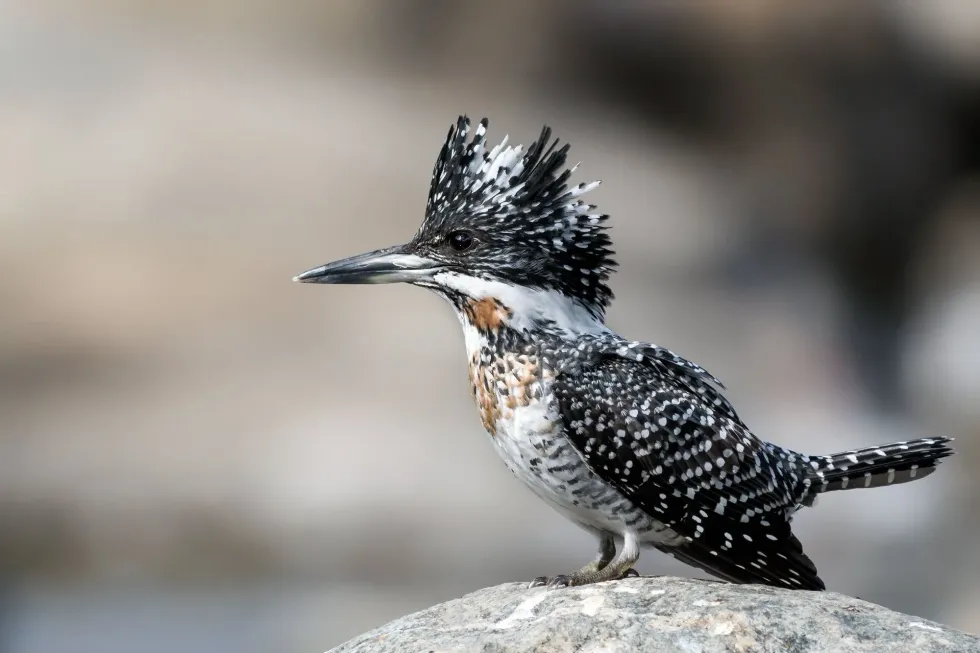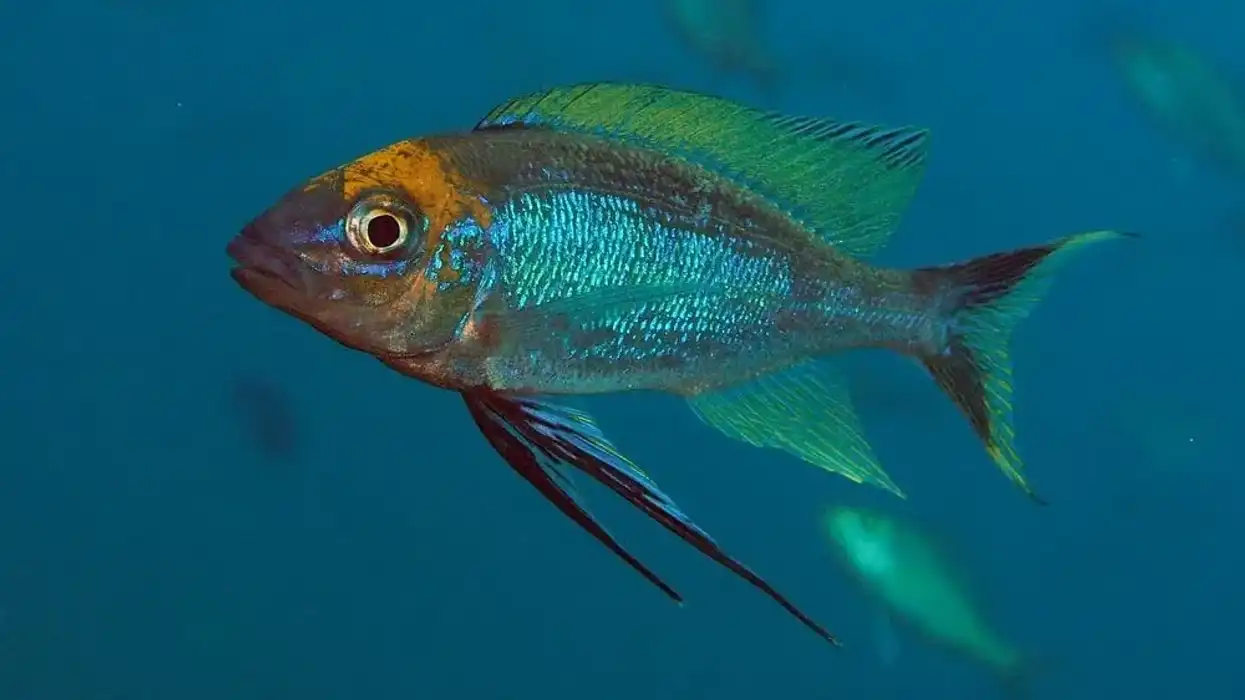The crested kingfisher, (Megaceryle lugubris) or Alcedinidae, are a family of tiny to medium-sized, vividly colored birds in the order of Coraciiformes found in India, Bangladesh, northern Indochina. They have a worldwide range, with the majority of species occurring in Africa, Asia, and Oceania's tropical areas.
There are 114 species in the family, which is classified into three subfamilies and 19 genera. The heads of all kingfishers are big, with long, sharp, pointed bills, short legs, and stubby tails.
They have barred wings and tails. The majority of crested kingfishers (Megaceryle lugubris) have colorful plumage with just minor differences between the sexes.
The majority of crested kingfisher (Megaceryle lugubris) species are tropical in range, with a minor majority found solely in forests. While many kingfishers are supposed to dwell near rivers and eat fish, several crested kingfisher (Megaceryle lugubris) species dwell inland and feed tiny invertebrates.
Crested kingfisher (Megaceryle lugubris) nests in holes and tunnels carved into natural or constructed banks in the earth, like other members of their order. Some kingfishers build their nests in arboreal termite nests.
A few crested kingfisher (Megaceryle lugubris) species, primarily insular types, are on the verge of extinction. In the United Kingdom, the term kingfisher usually refers to the common kingfisher. After reading these facts about the crested kingfisher, do check our other articles on belted kingfisher facts and giant kingfisher facts as well.
Crested Kingfisher Interesting Facts
What type of animal is a crested kingfisher?
The crested kingfisher (Megaceryle lugubris) is a big kingfisher with black and white plumage, evenly barred wings and tail, it lacks a supercilium and has spotted breast along with a shaggy crest and is found in regions of southern Asia.
What class of animal does a crested kingfisher belong to?
A crested kingfisher (Megaceryle lugubris) belongs to the Aves class of animals of the family Alcedinidae.
How many crested kingfishers are there in the world?
The current population of a crested kingfisher (Megaceryle lugubris) is unknown as no estimates have been made regarding its population in its habitat range. The populations of black and white kingfishers are concentrated around mountain rivers and larger rivers in the foothills of the Himalayas as well as Bhutan, Japan, and China.
Where does a crested kingfisher live?
Crested kingfisher (Megacryle lugubris) is mostly found in its habitat range around mountain rivers and larger rivers in foothills mountains and Himalayas. Their presence spans across Bhutan, Japan, and China as well.
What is a crested kingfisher's habitat?
Crested kingfisher (Megaceryle lugubris) species rely on forests to a lesser extent. This species of crested kingfisher (Megaceryle lugubris) may be found at elevations ranging up to 930 ft (2800 m) along the Himalayas.
These crested kingfisher (Megaceryle lugubris) species live in tropical and subtropical moist temperate forests, lowland forests, tropical and subtropical moist montane rivers, streams, forests, and creeks present at foothills of the Himalayas.
Who do crested kingfishers live with?
Crested kingfishers (Megaceryle lugubris) are solitary birds with a range of up to 3.1 miles (5 km). Because of this, as well as their timid demeanor, the crested kingfisher (Megaceryle lugubris) only appears to the most oblivious river ramblers mainly situated in India, Bangladesh, Bhutan, Japan, and China.
How long does a crested kingfisher live?
The typical lifespan of a crested kingfisher (Megaceryle lugubris) is two years, with a maximum documented age of four and a half years.
How do they reproduce?
In India and Nepal, the mating season for these crested kingfishers (Megaceryle lugubri) lasts from March to June. Crested kingfishers are monogamous, with wooing occurring before mating.
They are quite territorial, and their breeding grounds are on rivers and sandbanks. For their nest create burrows in banks around the rivers, but avoid river banks with vegetation. A normal clutch may have three to five eggs, and both parents incubate to feed the children.
What is their conservation status?
This crested kingfisher (Megaceryle lugubris) species has an exceptionally vast range and does not approach the Vulnerable levels based on the range size criteria. Even though the population trend appears to be declining, the fall is not seen to be fast enough.
As a result of these factors, the conservation status of this is classified as of Least Concern by the IUCN. The population size has not been measured, although it is believed to be insufficient to reach Vulnerable limits.
Crested Kingfisher Fun Facts
What do crested kingfishers look like?

The crested kingfisher (Megaceryle lugubris) has black and white plumage. They have barred wings and tails with sluggish features. It has a shaggy crest with long feathers. The crested kingfisher has a wide white collar, white underparts with black speckles and streaks here and there, and a white breast that is speckled and spotted black.
How cute are they?
The crested kingfisher (Megaceryle lugubris) is one of the cutest-looking birds around. The charming-looking small bird in flocks is so eye-catching and they are much cuter that way.
How do they communicate?
The black and white-crested kingfisher (Megaceryle lugubris) has keen vision and the capacity to polarize light. They also learn to correct refraction, which helps them catch prey more successfully.
A male black and white kingfisher will whistle loudly to a female and chase her through the trees while mating. They tend to make strident, mechanical rattles or loud screeching calls when threatened.
How big is a crested kingfisher?
The crested kingfisher (Megaceryle lugubris) is four times bigger than a bee hummingbird. The crested kingfisher is referred to as black and white kingfisher that ranges in size from 11-14 in (28-35 cm). The wingspan range id 19-23 in (48-58 cm).
How fast can a crested kingfisher fly?
When pursuing their prey, crested kingfishers (M. l. lugubris) may reach speeds of up to 44 mph (70 kph). They tend to fly in their habitat range of 3.1 mi (5 km) only.
How much does a crested kingfisher weigh?
The crested kingfisher is a kingfisher from the genus Megaceryle that weighs between 0.50-0.61 (0.22-0.27 kg).
What are the male and female names of the species?
There is no specific name for the male and female crested kingfishers. Hence, they are known as males and females respectively.
What would you call a baby crested kingfisher?
A baby crested kingfisher is called a chick.
What do they eat?
These crested kingfisher species eat large fish. A pied kingfisher's principal food sources include crayfish, fish, crabs, shrimp, frogs, and toads. Pied kingfishers are frequently spotted sitting on open tree branches or other good observation locations near the river. When they spot prey, this bird would dive headfirst.
Are they dangerous?
The pied kingfishers are famed for their speed and aggressive hunting habits, which include diving headfirst into the water to harpoon their prey with their sharp bills.
Would they make a good pet?
Crested kingfishers (Megaceryle lugubris), as a whole, do not make good pet birds. Pied kingfisher birds are wild birds, and the majority of them are neither friendly nor domesticated in any manner. It is unlawful in many countries to have a pied kingfisher as a pet.
Did you know...
Female kingfishers are more colorful than male kingfishers.
This bird species has black and white plumage, evenly barred wings, and a tail. It lacks a supercilium and has spotted breasts along with a shaggy crest.
Crested kingfishers (Megaceryle lugubris) are native to mountain rivers and larger rivers in foothills mountains and Himalayas.
What is special about the kingfisher bird?
The heads of all kingfishers are big, with long, sharp, pointed bills, short legs, and stubby tails. The majority of species have colorful plumage with just minor changes between sexes. The majority of species are tropical in range, with a minor majority found solely in forests.
How do kingfishers protect themselves?
To protect their eyes as they reach the water, all kingfishers have nictitating membranes that shield their eyes. In the protection of their nests, kingfishers are highly territorial.
Here at Kidadl, we have carefully created lots of interesting family-friendly animal facts for everyone to discover! Learn more about some other birds from our bean goose facts and mealy parrot facts pages.
You can even occupy yourself at home by coloring in one of our free printable crested kingfisher coloring pages.










